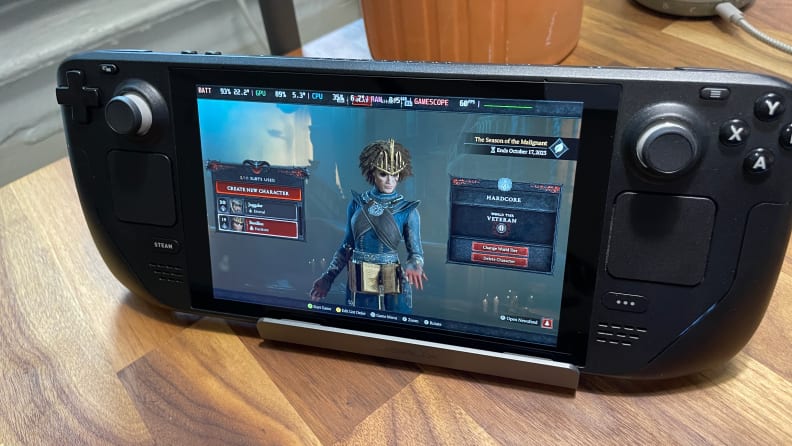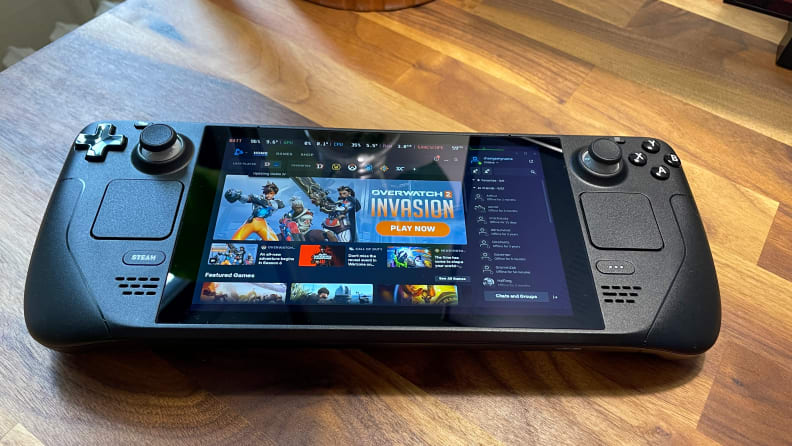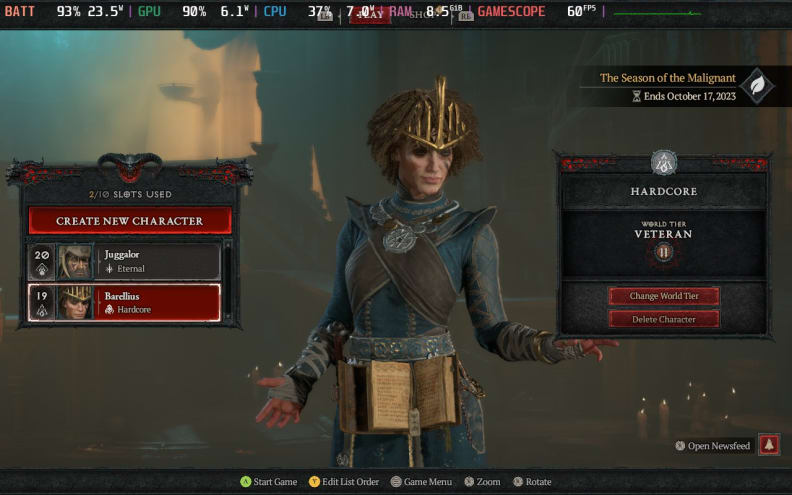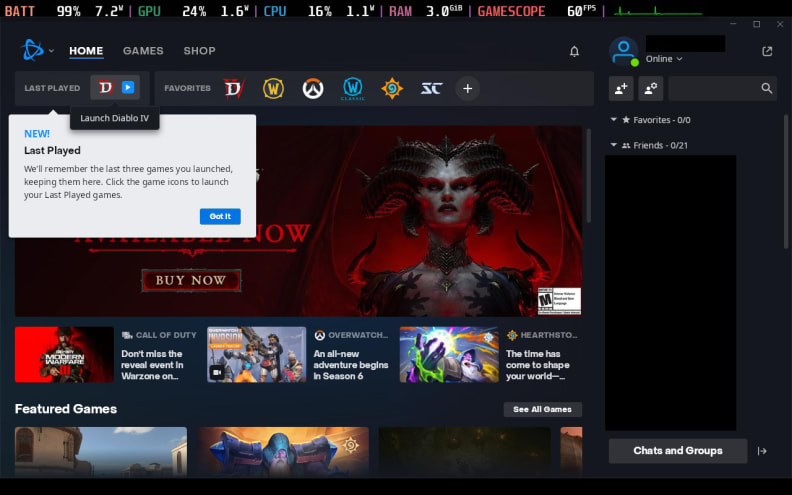Want to play Diablo 4 with your friends but don’t have a gaming PC? Don’t worry, the game is well-optimized, so even PC handhelds like the Valve Steam Deck can run it comfortably and the native controller support makes mapping all of your skills painless.
But while it’s easy to load up Battle.net on a Windows-based handheld like the Asus ROG Ally (and having tested it, Diablo 4 runs well at 1080p), getting Blizzard games up and running on the Linux-based Steam Deck takes a bit more work. Thankfully, it’s not too hard. Just follow these steps and you’ll be cutting through hordes of demons in no time. And you can even get other Blizzard classics like Hearthstone and World of Warcraft running.
Before you start

Credit:
Reviewed / Jonathan Hilburg
Getting Blizzard games up and running on the Linux-based Steam Deck takes a bit more work.
Diablo 4 is a 90GB download, so 64GB Steam Deck owners should look into upgrading their internal storage. I recommend the Corsair MP600, a 1TB 2230 NVMe drive that, at the time of writing, is on sale for $92. The replacement process should take less than an hour, and iFixit has a thorough guide on how to do it without damaging your Deck.

Corsair MP600 1TB 2230 NVMe M.2 PCIe Gen4 SSD
The Corsair MP600 Mini is fully compatible with Valve Steam Deck, Microsoft Surface, and other ultra-thin devices.
SD cards are a cheap and easy way to expand your Deck’s capacity, but newer big-name titles like Baldur’s Gate 3 can reportedly stutter when played off of them due to how fast game assets need to be streamed. So it’s a much better option to go with an internal NVMe drive.
Install Proton GE
Now it’s time to install Proton GE (or Glorious Eggroll), a community Linux distribution that opens up compatibility with several non-native apps and even improves how well certain Steam games run on the Deck.
Parts of this setup should be familiar if you’ve installed emulators before. You may want to connect a keyboard and mouse to your Deck before diving in to make things easier, but it’s not required.
- Hold down the Steam Deck’s power button and switch to Desktop Mode.
- Navigate down to the blue shopping bag icon at the bottom left to open the Discover program.
- Search for ProtonUp-Qt and install it.
- Launch ProtonUp-Qt and hit the Add Version button when the program opens.
- Install GE-Proton when prompted. If you don’t install Proton GE, Battle.net might not run at all.
Install Battle.net on the Steam Deck

Credit:
Reviewed / Jonathan Hilburg
By default, you can only navigate Battle.net with touch controls, but this can be fixed by navigating to the controller settings within the Steam menu and switching the layout to “Gamepad with Mouse Trackpad.”
Battle.net needs to be added to Steam before it can be installed properly.
- While in Desktop mode, open up a web browser window and navigate to Blizzard.com and download the Battle.net installer.
- Then open Steam.
- Navigate to the Game menu and select Add a Non-Steam Game to my Library.
- Hit Browse at the bottom of the menu.
- Head to your downloads folder and select Battle.net-Setup.exe.
- Click the Add Selected Programs button.
- Next, navigate to the installer’s entry in your Steam library and press the settings cog button on the right.
- Go to the Compatability tab on the left-hand side of the dialogue box that pops up, and then check Force the use of a specific Steam Play compatibility tool.
- Select Proton Experimental from the drop-down menu.
- Run the Battle.net installer. (Don’t let your Steam Deck fall asleep during this process.)
- Once it’s complete, don’t log in when prompted; instead, close Battle.net and navigate back to Add a Non-Steam Game to my Library, then hit Browse again.
It’s time to add the Battle.net app to your Steam library properly, but you’ll have to do some digging in the Deck’s file storage to find it.
- Click the top-right button for Options (it should look like two sliders stacked on top of each other) and select Show Hidden Files.
- Click the small arrow next to Home to jump to the home file level, and open Deck.
- From there, navigate to the .local folder > share > Steam > steamapps > compatdata.
- The final browser address will be home/deck/.local/share/Steam/steamapps/compatdata/.
Now you should see a list of folders that all have 10-digit numerical names. Using the dates on the right-hand side of the file navigator, open the most recently created folder.
- Once you’re inside, navigate to pfx/drive_c/Program Files (x86)/Battle.net.
- Select Battle.net Launcher.exe and then Add Selected Programs.
- Navigate to the new Battle.net launcher in your library, and force Proton Experimental compatibility.
- Launch Battle.net and log in.
By default, you can only navigate Battle.net with touch controls, but this can be fixed by navigating to the controller settings within the Steam menu and switching the layout to Gamepad with Mouse Trackpad, which will let you move around with the trackpads. You can map a left and right mouse click to the appropriate triggers, too.
I recommend attaching a keyboard for this part as the virtual keyboard on the Deck sometimes glitches out while navigating Battle.net.
Time to game

Credit:
Reviewed / Jonathan Hilburg
Don’t expect 100% compatibility with all of Blizzard’s games though, as Call of Duty: Modern Warfare 2 and other competitive shooters use anti-cheat software that renders them incompatible with the Deck.
Once you’re in, that’s it! Go ahead and install Diablo 4 and launch the game. It should detect your controller right away, so you can immediately play.
I recommend plugging your Deck into a dock with a wired Ethernet connection to speed up the download process. Don’t forget, though, that Diablo 4 is an “always online” game that requires an internet connection to run. So even though you can take it with you anywhere, you can’t play it anywhere.

JSAUX Docking Station
The JSAUX Docking Station is compatible with the Valve Steam Deck and ASUS ROG Ally.
I’ve found that setting the resolution to the Steam Deck’s native 800p (1280 x 800 pixels), putting everything else to Medium and enabling FSR (AMD’s upscaling technique), and setting it to Balanced ensured a steady 60 frames per second (fps) with only minor hitching and dips.
While the default layout for an attached Xbox controller is all right, I’m personally not a fan; don’t be afraid to reassign them. In fact, feel free to change the layout in any way you see fit, or even use the right trackpad as a mouse and for greater precision.
Running other Blizzard games

Credit:
Reviewed / Jonathan Hilburg
Diablo 4 is a 90GB download, so 64GB Steam Deck owners should look into upgrading their internal storage.
Running Hearthstone and World of Warcraft on the Steam Deck is just as easy, and there are even community-made controller schemes available for WoW and other games in the Steam settings menu.
Don’t expect 100% compatibility with all of Blizzard’s games though, as Call of Duty: Modern Warfare 2 and other competitive shooters use anti-cheat software that renders them incompatible with the Deck.
Most importantly, this article might eventually become obsolete as Blizzard has announced that it would be (slowly) migrating its games to Steam. While it’s not public whether your favorite games will make the cut, Overwatch 2 is already available as of August 10.











